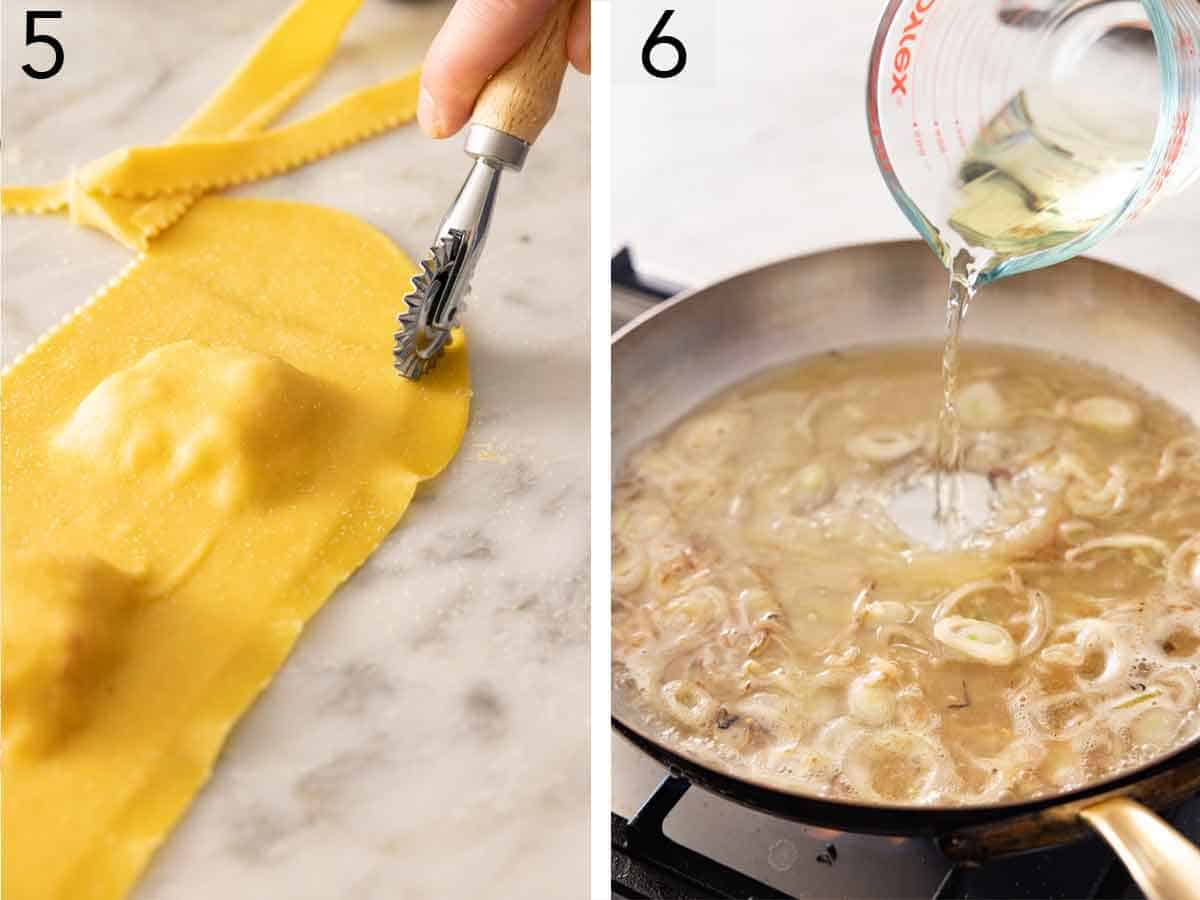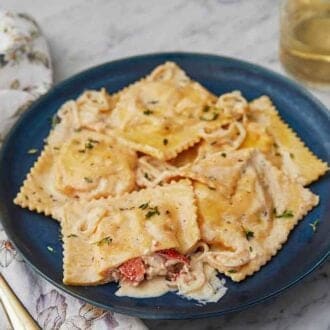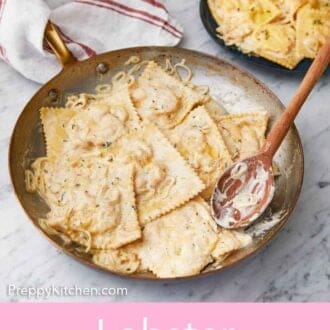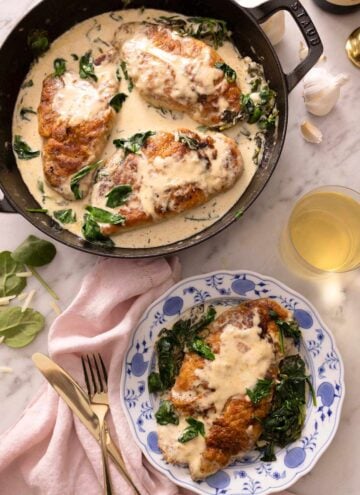If you’re looking to impress your guests or feel extra romantic, make this delicate but delicious lobster ravioli recipe. It’s a simple but elegant recipe that will delight anyone you serve it to. While making homemade pasta for ravioli seems complicated, I promise that it’s not! If you’ve never made your fresh pasta, just know that while the process is not quick, it’s easier than you might think.
This made from scratch lobster ravioli is just as tasty, if not better, than what you’d get at your local Italian restaurant. The slight sweetness of the lobster paired with the bright and creamy sauce makes for a velvety and luxurious dish that will make your mouth water! Need a side dish to go with your homemade ravioli? Try my garlic bread recipe or dinner rolls recipe.
What You Need to Make This Recipe

Pasta dough — you only need flour, eggs, olive oil, and salt to make homemade pasta dough.
Lobster meat — as the lobster is the star of the filling, make sure you use the best quality lobster you can find. Fresh lobster tails are best.
Ricotta — using ricotta cheese for the ravioli keeps the filling firm but creamy.
White wine — adding white wine to the sauce helps balance out the richness. White wines such as Pinot Grigio, Sauvignon Blanc, Pinot Gris, or Pinot Blanc work for this recipe.
Heavy cream — to make the sauce thick and creamy, you’ll need heavy cream. For a lighter alternative, you can swap with half and half.
How to Make Lobster Ravioli

1. In a large bowl, stir together the lobster, garlic, ricotta, lemon zest, salt, and pepper until combined.
2. Divide the pasta dough into quarters and lightly dust with all-purpose flour to keep the pasta from sticking. Roll out each half using a pasta roller, beginning on the largest opening, Number 1, and gradually decreasing to the Number 5 setting. (You can also roll this by hand with a rolling pin to 1/16-inch thick.) See the recipe card down below for my homemade pasta dough.

3. Place one dough sheet on a clean work surface, dollop the lobster mixture in 1 tablespoon portions about 1-inch apart.
4. Brush the dough around the filling with water. Top with the other dough sheet, and press around the filling to seal.

5. Cut into squares. Place the ravioli on a baking sheet, and refrigerate, uncovered, while continuing.
6. Melt the butter in a large skillet over medium-high heat. Add the shallots. Cook, stirring often, until translucent, about 1 minute. Add the wine. Cook, stirring often until reduced by half. Whisk in the cream, sage or thyme, salt, and pepper. Cook, whisking constantly until slightly thickened, about 2 minutes. Remove from the heat.

7. In a large pot of salted boiled water, add the chilled ravioli. Cook stirring occasionally, until the pasta is tender, about 2 to 5 minutes.
8. Using a slotted spoon, transfer the ravioli to the skillet with the cream sauce. Place the skillet over medium-high heat and return to a simmer, stirring occasionally, adding 2 to 4 tablespoons of pasta water if needed to loosen the sauce. Serve the lobster ravioli immediately.

Pro Tips for Making This Recipe
- If you are making your pasta dough, make sure to prepare the dough first, as it’s best to give the dough time to rest.
- Make sure to roll the pasta as thin as possible, as homemade fresh pasta dough gets slightly thicker when it cooks.
- When chopping the lobster meat, make sure to chop it finely. This helps you evenly distribute the lobster meat in the filling.
- Before making the ravioli filling, make sure the lobster has completely cooled before mixing the filling and adding it to the pasta.
- Be careful not to overfill your lobster ravioli, or they won’t seal properly.
- If you do not have a ravioli cutter, you can use a cookie-cutter. A cookie-cutter will yield the most uniform portions of ravioli. You can use circle, square, heart, or diamond-shaped cookie cutters to change up the shape of the lobster ravioli.

Frequently Asked Questions
Do I need to use fresh pasta dough?
If you do not want to make homemade pasta dough, you can buy fresh pasta sheets or use wonton wrappers. However, I highly recommend trying your hand at making homemade pasta dough for the ravioli if you have the time. It’s worth the effort! If using wonton wrappers, lightly wet the edges of the wrapper with water. Place 1 tablespoon of the lobster mixture in the center of the wrapper. Top with another wonton wrapper and press it down around the filling to get out any air bubbles and seal the edges. Repeat with the remaining lobster filling and wonton wrappers.
How do I store leftovers?
Place leftover lobster ravioli and the sauce in an airtight container and store in the fridge for up to four days. You can gently reheat the sauce and ravioli on the stovetop until everything is warm.
How do I freeze this?
If you want to freeze this lobster ravioli recipe, then transfer it to a lined sheet pan before cooking them. Flash freeze the filled pasta until frozen and transfer to a freezer-safe bag or container for a month. When ready to cook, do not thaw. Boil frozen ravioli for an additional 1 to 2 minutes or until the ravioli float to the top of the water.
How do I cook the lobster meat?
To cook the lobster meat, place 4 to 6 fresh or thawed lobster tails in a shallow pan. Add enough water just to cover the bottom. Bring to a simmer over medium heat, cover, and cook for 3 to 5 minutes or until the meat is opaque and the shells are bright red. Remove the tails from the pan and let cool before removing the meat from the shell.
Can I use frozen lobster for the filling?
You can use frozen cooked lobster for the lobster ravioli filling instead of fresh lobster. You will have to thaw the meat before mixing it with the rest of the filling ingredients. Keep in mind that you should not freeze the ravioli if you use frozen lobster meat.
If you’ve tried this Lobster Ravioli recipe, then don’t forget to rate the recipe and let me know how you got on in the comments below, I love hearing from you!

Lobster Ravioli
Video
Equipment
- mixing bowl
- Pasta roller
- Skillet
- Large Pot
Ingredients
For the Homemade Pasta Dough:
- 2 cups all-purpose flour (240g)
- 3 large eggs
- 1 tablespoon olive oil
- ½ teaspoon salt
For the Ravioli Filling:
- 12 ounces cooked lobster meat chopped (2 cups chopped/342g)
- 3 cloves garlic minced (1 tablespoon/ (9g)
- 1 cup whole milk ricotta cheese (250g)
- 2 teaspoons lemon zest
- ¾ teaspoon salt
- ¼ teaspoon ground black pepper
- 1 pound homemade pasta dough (450g)
For the Sauce:
- 1 tablespoon unsalted butter
- 1 shallot thinly sliced (35g)
- ¾ cup dry white wine (180mL)
- ½ cup heavy whipping cream (120mL)
- 1 teaspoon finely chopped fresh sage or thyme
- ½ teaspoon salt
- ¼ teaspoon ground black pepper
Instructions
For the Pasta Dough:
- Place the flour in a mound on a clean work surface and make a well in the center. Add the eggs, olive oil, and salt. Begin beating the eggs with a fork to break them up. Slowly start to mix in the flour while beating. Continue until a shaggy mixture forms.
- Working with your hands or a bench scraper, begin folding the mixture together until a dough ball forms. Knead the dough until it is smooth and elastic, about 10 minutes, sprinkling with additional flour if needed to keep the flour from sticking to your hands or the counter. Wrap the dough tightly in plastic wrap and let it rest at room temperature for at least 1 hour and up to 3 hours.
For the Ravioli Filling:
- In a large bowl, stir together the lobster, garlic, ricotta, lemon zest, salt, and pepper until combined.
- Divide the pasta dough into quarters and lightly dust with all-purpose flour to keep the pasta from sticking as needed. Roll out each half using a pasta roller, beginning on the largest opening, Number 1, and gradually decreasing to the Number 5 setting. (You can also roll this by hand with a rolling pin to 1/16-inch thick.) Place one dough sheet on a clean work surface, dollop the lobster mixture in 1 tablespoon portions about 1-inch apart. Brush the dough around the filling with water. Top with the other dough sheet, and press around the filling to seal. Cut into squares.
- Place the ravioli on a baking sheet, and refrigerate, uncovered, while continuing. (Ravioli can also be frozen and stored in an airtight container for up to 1 month.)
For the Sauce:
- In a large pot, bring 4 quarts of water and 1 tablespoon of salt to a boil over medium-high.
- Meanwhile, melt the butter in a large skillet over medium-high. Add the shallots. Cook, stirring often, until translucent, about 1 minute. Add the wine. Cook, stirring often until reduced by half, about 4 minutes. Whisk in the cream, sage or thyme, salt, and pepper. Cook, whisking constantly until slightly thickened, about 2 minutes. Remove from the heat.
- When the water is boiling, add the chilled ravioli. Cook stirring occasionally, until the pasta is tender, about 2 to 5 minutes. Using a slotted spoon, transfer the ravioli to the skillet with the cream sauce. Place the skillet over medium-high heat and return to a simmer, stirring occasionally, adding 2 to 4 tablespoons of pasta water if needed to loosen the sauce. Serve immediately.
Notes
- If you are making your pasta dough, make sure to prepare the dough first, as it’s best to give the dough time to rest.
- Make sure to roll the pasta as thin as possible, as homemade fresh pasta dough gets slightly thicker when it cooks.
- When chopping the lobster meat, make sure to chop it finely. This helps you evenly distribute the lobster meat in the filling.
- Before making the ravioli filling, make sure the lobster has completely cooled before mixing the filling and adding it to the pasta.
- Be careful not to overfill your ravioli, or they won’t seal properly.
- If you do not have a ravioli cutter, you can use a cookie-cutter. A cookie-cutter will yield the most uniform portions of ravioli. You can use circle, square, heart, or diamond-shaped cookie cutters to change up the shape.















Lisa says
Excellent homemade pasta recipe. I’ve tried many of your recipes and they’re ALL fantastic!
Joel says
I’m from New England and this was legitimately the best lobster ravioli I’ve ever had! A+++ and the sauce was perfection!
Mary Beth says
Delicious. I did add a bit of freshly grated parm to the filling.
Lauren Moreale says
I made this recipe for a romantic dinner in with my boyfriend who is a foodie. Holy moly was it PHENOMINAL!! I followed the dough and filling recipes to a T, but I adjusted the sauce by adding more butter and I’m glad I did, but I’m a butter whore so take my input with a grain of salt. Definitely will make again when I need a dish to impress. Thank you!!
Xtina says
This hand made dough was fool proof and turned out fantastic! Can’t wait to make it again
Rick says
Made half recipe for 2024 New Years dinner. Pasta and filling were great. The only drawback to scaling the recipe was the quantity of sauce as there was not enough. If I were to make it again I would make 3/4 or a full order of sauce for a half order of pasta.
Dan says
First time making pasta myself and why not make ravioli, so I tried this lobster recipe… Recently had the best lobster ravioli ever at a high rated Italian restaurant… but I must admit this was indeed the best way to make your own and I’d say it tastes even better! 5 stars all around! Can’t wait to try another recipe. It takes some time, but worth every minute!
Margaret Morris says
We used Dungeness Crab in this recipe. The best ravioli ever. Our new favorite way to enjoy crab. Better than any restaurant. You won’t be disappointed.
Laura Strachan says
Really delicious! Not a great first attempt at making ravioli, but it worked 😊
I found it needed a bit of lemon on the side, and garnished with chives as per my own personal preference
Will definitely make again 😊